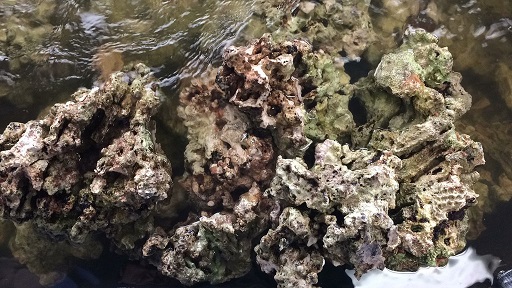What is Live Rock
When talking about live rock (LR), it is a misconception that the rock itself is alive, or that live rock can die. What makes it live are the many forms of micro and macroscopic marine life that live on and inside of it. The rock itself is only made up of the calcium carbonate skeletons of long dead corals and broken ocean floor rock. What makes aquarium live rock called live rock are the forms of good bacteria and macroscopic life that form inside the rock and on
the surface of the rock. Live rock is collected by divers on many islands in the pacific and atlantic. Then it makes its way by ship or air to the USA and other destinations, then to the aquarium shops, and finally into your home aquarium. There are different types of live rock. In J. Charles Delbeek's article "Your First Reef Aquarium," published in Aquarium USA in 1994, the Live Rock section refers to "reef rock" basically as "pieces of coral or coral rock from outside the reef. The coral has broken off and fallen to the bottom becoming covered with encrusting organisms, such as coralline algae and sponges." "Inshore live rock" Delbeek refers to as rock from inside the reef that has a tendency to be denser and becomes covered with macroalgae, clams, mussels, crabs, shrimps, and other marine organisms. There is also rock called Base Rock, meaning it has no forms of micro and macroscopic marine life that live on and/or inside of it.. Base rock is used as a money saver when building a reef. Use it as the base for the nicer looking live rock and place corals on top of it to build your reef system.
What Is The Purpose of Live Rock?
For the aquarium trade Live Rock is highly valued not only for the diversity of life it can bring to the closed marine environment, but its function as a superior biological filter that hosts both aerobic and anaerobic nitrifying bacteria required for the nitrogen cycle that processes waste. Live rock becomes the main biological nitrification base or biological filter of a saltwater aquarium, while at the same time enhances the look of the aquarium and provides shelter for the inhabitants. To better understand what purpose live rock serves in an aquarium, Delbeek explains it like this: "The use of live rock immediately introduces into the aquarium numerous algae, bacteria and small invertebrates all of which contribute to the overall quality of the aquarium water. Live rock has just as much, if not more, surface area for bacteria as a trickle filter. Since live rock in the aquarium contains various types of bacteria, algae, and corals, waste products such as ammonia, nitrate, and phosphate can have a number of fates. Ammonia, nitrate, and phosphate are readily assimilated by algae and photosynthetic corals growing on and in the rock. Ammonia can also be quickly converted into nitrate by the bacteria on and in the rock. Then the nitrate's can be absorbed by the algae and corals, or bacteria can denitrify it in proximity to the nitrate producing bacteria." For the above reasons trade live rock has replaced the old wet dry filters we used to use with bio balls for the nitrifying bacteria. Live rock has become the most effective biological filter we have for the marine saltwater aquarium. Very quickly once placed in the aquarium, usually within just a few weeks, biological magic takes place and the live rock gains beneficial bacteria. The rock hosts both aerobic and anaerobic nitrifying bacteria required for the nitrogen cycle that processes waste. Live rock becomes the main biological nitrification base or biological filter of a saltwater aquarium. Additionally live rock has a stablizing effect on the water chemistry, in particular on helping to maintain constant pH by the release of calcium. Lastly, live rock, especially when encrusted with multiple colors of coralline algae, becomes a major decorative element of the aquarium and provides shelter for the inhabitants. It's often used to build caves, arches, overhangs, or other structures in the tank, an art known as aquascaping.
Coralline Algae and What's it Got To Do With Live Rock?
Coralline Algae is an encrusting algae with the color dependent on where the live rock comes from. Coraline Algae will not appear in a tank or closed system on it’s own like other nuisance algae. It must be introduced into your aquarium, usually from purchased Live Rock or scrapings from a friends saltwater tank. Many Islands Live Rock actually have many different species and colors of Coralline, all competing for space on the rock. With hundred's of known species of coralline algae we see colors of pink, varying shades of purple, and red, green, white, yellow, orange, blue, and on and on. Found in every ocean, in inter-tidal zones that are exposed at low tide, all the way down to 1,000 feet deep. Coralline Algae is a slow and steady type grower. At first glance, you may take note of the pretty colors, almost like an artist came along and left some abstract pink and purple brush strokes all over the live rock. While Coralline Algae is a colorful component and adds to the overall aesthetics of your live rock, it also shows the stage and health of your saltwater aquarium's closed tank ecosystem.
How Can I Get More Coralline Algae to Grow in My Aquarium?
Coralline Algae will not appear in a tank or closed system on its own like other nuisance algae. It must be introduced into your aquarium from Live Rock and by hitchhiking in on snails and hermit crabs that were collected in the wild. It can tolerate a wide range of conditions and nutrient concentrations. Basically it can survive any marine environment that sunlight can get to. Here are some tips for helping you get the most Coralline possible in your reef tank.
1)Aquatic life loves stability and so does coralline algae. Try to keep your water parameters stable through regular monitoring and water testing. Smaller more frequent water changes are preferred over larger less often water changes, this helps eliminate any shock to your system.
2)Try to Keep your nitrates below 15 ppm.
3)Keep your Phosphates <0.25 ppm.
4)Keep a stable pH level between 8.1-8.3 (when testing for pH, it is important to always test at the same time of day as pH levels fluctuate with the light cycle).
5)Keep a stable KA level of 2.8 meq/L for alkalinity or carbonate hardness (the concentration of carbonate and bicarbonate). Your level can be +/- up to 0.14 meq/L. Having a correct KA level in your tank will also have a stabilizing effect on your pH, which will keep your fish happy (although your crabs may still be crabby).
6)If you are doing regular water changes at least 1-2x’s monthly you may not need to dose magnesium and calcium, if not then you may need to test and dose these. Coralline Algae is a calcareous algae so it utilizes both magnesium and calcium in its structure and would not be able to reproduce without them.
7)Maintain a stable temperature. The type of fish tank you have and it’s inhabitant’s will determine your optimum tank temperature, but 78-81 degrees Fahrenheit is common. The main goal with temperature is to not allow it to fluctuate.
8)Lighting is key. The most vibrant colors of Coralline Algae need excellent lighting. The intensity, or “PAR” level, of your lighting shouldn’t be too high or too low, and the duration of your photo period should be somewhat close to the natural duration of the sun. Your aquarium shouldn’t receive full intensity sun baked lighting for 7 or 8 hours, because that is not natural. Modern LED lighting has come so far that now a days it can replicate a period of lighting from sunrise to sunset. We highly recommend getting an excellent LED light or Hybrid LED/T5 light over that tank of yours.
Types of Live Rock You will Find
Many types of Aquarium Rock are available for the saltwater aquarium hobbyist. For years there's been wild collected from Islands all over the world. Now add on to that really good man made, and aqua-cultured rock. Below are a brief description of the most commonly found types of aquarium rock.
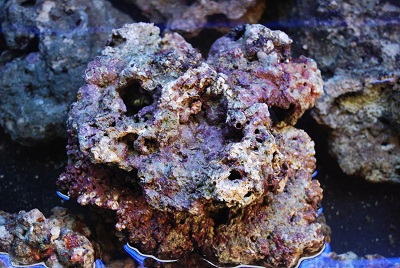
Fiji Live Rock, click for page
Fiji Live Rock
Probably the most familiar name in aquarium live rock is Fji Rock. Fiji live rock is available from some suppliers who beleive as we do in air shipping live rock in. Other suppliers who must sell at very discounted pricing will sell Fiji live rock because it is also available shipped in by boat. By boat Fiji rock will still have some great shapes to it but expect the outer topical layer of coraline to take more of a hit. Fiji Rock IS true live rock with purple colors of coralline and since it is true live rock it therefore needs to be cured.
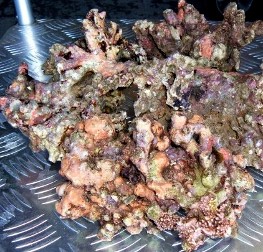
Bali Alor Live Rock, click for page
Bali Alor Live Rock
Bali Alor is harvested right around the coral reefs themselves. Therefore Bali Alor Liverock is made from ancient encrusted coral heads, the corals that were broken in storms, that have fallen and were encrusted with coraline algae over time. It is very beautiful and very light weight! The advantages of using Bali Alor Live Rock is the incredible diversity of coloration, and unique shapes. It is also lighter than Fiji Premium Live Rock so you need to purchas less rock. For Bali Alor Live Rock we recommend only 1 to a maximum of 1-1/2 pounds per gallon where Fiji rock would require more per gallon to look the same. For aquascaping, it is acceptable to alter the shapes and sizes of the rock with a hammer and chisel. This will not damage the integrity of the rock, nor it's inhabitants. Please, just make sure you wear safety glasses. Bali Alor live rock will color up with an incredible variety of unique colors. You will see purple, pink, red, yellow, and green coralline algae. Where Fiji live rock will color only in the purples. Bali Alor is true live rock therefore needs to be cured.
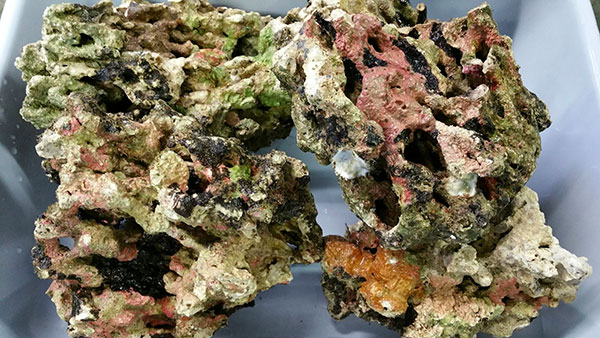
Caribbean Reef Rock, click for page
Caribbean Reef Live Rock
Caribbean Reef live rock is 100% naturally collected from the ocean. Every piece of Caribbean Reef Live Rock we receive is unique and a celebration of the oceans ability to create beauty from nature. Caribbean Reef Live Rock is lightweight and porous giving the user the ability to create an aquascape that's both beautiful and functional. When we receive a new shipment of live rock from our airport we first place all the live rock into our special runway vats used for cleaning and curing. When clean and cured the live rock is then placed in a clean saltwater runway which is totally free of live pests and hitch hikers. Where it stays continuing to be hydrated until orders come in for ship out. For shipping we carefully wet wrap each piece, and carefully place in one of our shipping containers. Styrofoam peanuts are used to both separate pieces and to fill any voids in the shipping box. When you receive your live rock we guarantee your live rock to be 100% naturally collected from the ocean making it highly beneficial for a strong biological filter. Aquascapes built with Caribbean Reef Live Rock will provide excellent water circulation and a multitude of hiding places for both fish and invertebrates to hide in and de-stress.
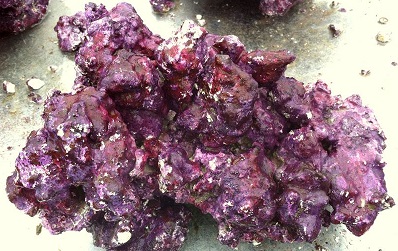
"Real Reef" Man Made Live Rock, click for page
"Real Reef Rock" Man Made Aquarium Live Rock
Real Reef Rock is made of 100% natural Eco Friendly green materials. Materials composed of the same mineral building blocks as coral skeleton live rock, without the environmental damage to the World's Coral reefs. Real Reef is composed of several different types of mineral aggregates. Some are very similar to high end media used in modern Calcium Reactor dosing systems. Real Reef Rock is high in Calcium Carbonate, with amounts in the 82-85% range. Unlike coral skeleton which is primarily Calcium Carbonate, Real Reef Live Rock contains a variety of essential trace elements and minerals. This remaining 15-18% consists of minerals and trace elements such as: Magnesium, Strontium and Iron.
It takes over 13 steps to manufacturer Real Reef Rock and every piece is unique and different, but not ugly! No two pieces are the same, just like Mother Nature! Real Reefs multiple ingredients are bonded together with natural calcium based binders; the process used does not use any chemicals or synthetic epoxies or glue. It is through this labor intensive proprietary Patent Pending process that makes Real Reef mimic some of the best coral Live Rock shapes the aquarium industry has seen.
Real Reef's beautiful shades of Purple, Pink and Red come from a water based non-toxic natural pigment. Their proprietary pigments are injected and applied through several techniques and processes. Once the Real Reef Rocks are created, they go through a pre grow-out preparation. This pre grow-out freshwater curing process lasts for a minimum of 12 weeks. Once the rock has completed the curing process, it is then transferred to saltwater grow-out for a minimum of 12-16 weeks. Their marine grow-out facility consists of large 3,000 and 10,000 gallon fiberglass raceways in climate controlled greenhouses. It is in these filtered closed system raceways that Real Reef Rock becomes a biologically active aquarium live rock. From the grow-out raceway systems Real Reef Rock is prepared, packed and shipped to distributors and retailers worldwide.
To Cure or Not To Cure, That Is Your Question?
Live rock must be cured to allow the organic and decaying marine life living on the live rock to naturally die back without poisoning the actual aquarium water. The die back will always occur in transported live rock and it's very important to allow it to die off so that the good remaining life in and on the live rock will grow and flourish. As the marine organisms on the rock go through a die back, they will produce a large amount of waste material and cause toxic levels of ammonia to be released into the aquarium. This is very bad for the aquariums marine life therefore curing your live rock outside of your aquarium will insure a safe addition of new live rock into your aquarium. Rest assured the majority of very beneficial nitrifying bacteria survives the curing process by hiding deep in the pores and crevices of the live rock. In addition, some of the corals and invertebrates will also not die off completely and will begin to re-emerge in the new aquarium over time.
How long the curing process takes depends on how clean the live rock that comes in is. Live rock that has been shipped to you fairly clean and cured at the shippers location will have minimal decaying organic matter left on it when it arrives at your door. This Live Rock will smell fresh, it won't stink. If it smells clean the curing time will most likely be a week or less. On the other hand, if your Live Rock arrives with a strong smell and shows lots of decay organics on the rock, the live rock will usually cure within a week or two. Finally a suggestion that is very smart is to be sure whomever you purchase your live rock from, make sure they package their live rock for shipping to arrive at its destination with some humidity still captured inside the bag of live rock. That just means the inside bag and the live rock box must be sealed well. Your live rock will be in better shape on delivery.
Correct Method of Curing Live Rock?
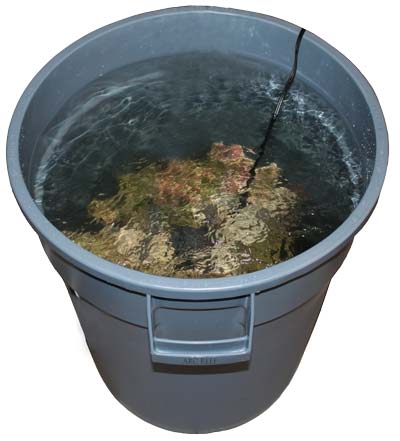
Gather These Items For Live Rock Curing
You will need a 30 gallon large container, we suggest a rubber garbage can or large 30 gallon bin. You will also need an aquarium powerhead to move water in the container around your live rock. You will need an aquarium heater, and last you will need a Saltwater Ammonia Test Kit.
Follow These Steps For Live Rock Curing
-Place your new live rock in the 30 gallon container and place freshly mixed up saltwater higher than the level of the live rock in the container.
-Set your heater to 80 degrees to speed die off and the curing process.
-Add your powerhead to have good water movement.
-Cover the container as best you can.
-Change all of the saltwater in the container twice a week. To speed the curing process at the same time you are changing the water, scrub the rock to remove any dead material.
-Check the water with your ammonia test kit. When the ammonia level is 0 ppm or barely detectable then your curing process is finished and the live rock is safe to place in your aquarium.
Well that's It. We hope that all your questions were answered and that this was helpful. If you have any questions please write us at Help.ACOL@gmail.com
|

